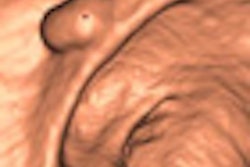ORLANDO - Using a sequential scanning mode during coronary CT angiography (CTA) studies cuts radiation dose in half without impairing image quality compared to standard retrospective spiral data acquisition, according to a study presented at this week's American College of Cardiology (ACC) meeting.
In an analysis of the international Prospective Multicenter Study on Radiation Dose Estimates of Cardiac CT Angiography in Daily Practice (PROTECTION I), Dr. Jörg Hausleiter from the German Heart Centre Munich in Germany and colleagues scrutinized images from several institutions that used the new technique -- prospective electrocardiogram-triggered sequential coronary CTA -- aimed at lowering the radiation dose delivered with current coronary CTA technology.
The researchers compared results obtained from 1,445 spiral coronary CTA scans with 99 sequential coronary CTA studies performed at five of the 50 centers in the study. The conventional spiral CT scans were performed with 64-slice CT scanners from all four major CT manufacturers: GE Healthcare of Chalfont St. Giles, U.K.; Philips Healthcare of Andover, MA; Siemens Healthcare of Erlangen, Germany (single- and dual-source); and Toshiba Medical Systems of Otawara, Japan.
The sequential coronary CTA scans were performed mainly on the GE scanner, with 87 of the 99 scans; 11 were performed using the Philips system, and one scan was performed with a Siemens dual-source unit.
The researchers rated both image quality and radiation dose delivered with the systems in both scanning modes. In terms of image quality scores, the researchers found virtually no difference between the two techniques, with an average image quality score of 3.5 achieved for each method (p = 0.82).
However, the dose length product (DLP) of radiation was 902 for the standard approach compared to 269 for the sequential technique, a clearly significant difference (p < 0.001), Hausleiter said. The DLP translates into a radiation dose of 12.6 mSv for standard CT scanning and 5.6 mSv for the sequential technique.
The results show that sequential scanning delivers less radiation to patients without the loss of image resolution needed to diagnose cardiac abnormalities, he said. But future studies are needed to further prove the technique.
Owing to potential selection bias, "future randomized studies are needed to prove the noninferiority in image quality of the sequential scan mode when compared with spiral scanning," Hausleiter said.
By Edward Susman
AuntMinnie.com contributing writer
March 31, 2009
Related Reading
Prospective coronary CTA performs well in heavy patients, February 27, 2009
Step-and-shoot mode minimizes dose in dual-source cardiac CT, September 29, 2008
Copyright © 2009 AuntMinnie.com

















